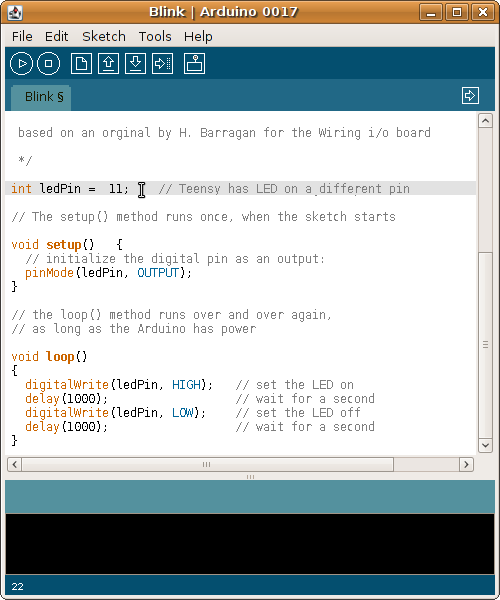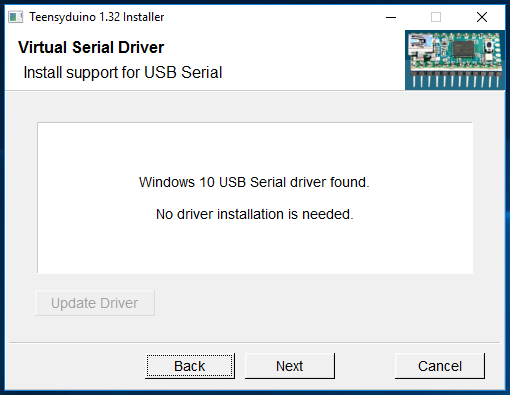


- #Teensy driver 2.0 how to
- #Teensy driver 2.0 install
- #Teensy driver 2.0 portable
- #Teensy driver 2.0 code
VIH (High-level input voltage) is specified as 2.3 to VCC1 (which is supposed to be 4.5 to 7 volts). On page 5 near the top is "recommended operating conditions".

Is the 3.3 pwm enough for controlling motor speed while using motor driver ICs like l293d? Or should I convert it to a 5v pwm using opamps circuits? Or Is the 3.3 v enough to drive the transistors in l293d to saturation and achieve max speed?
#Teensy driver 2.0 code
I might even be able to answer a few questions, since I've written code for all of them, though some features I still haven't used. If you really want to learn the hardware timers, you certainly can. You won't find a lot of writing online about this, because the chip is so new that relatively few people have done so and written about it (or perhaps lived to tell the tale.) Because of IntervalTimer, analogWriteFrequency and analogWriteResolution, probably fewer people will do so (as probably should have happed with Arduino many years ago, but never did, causing so many people to have to dig into the hardware). On Teensy 3.1, the timers are dramatically more capable, which means there's a LOT more to read and learn to use them. Even on AVR, the timers have a lot of features. The chip's documentation explains how the hardware works and has a list of registers you can access to control it. In concept, it's pretty much the same as AVR.
#Teensy driver 2.0 how to
You could look at PulsePosition.cpp for some idea of how to access the timer hardware directly. Just recently I wrote a PulsePosition library that makes extensive use of the Teensy 3.1 FTM0 timer. Usually more advanced timer stuff is done deep within libraries. If you're wanting the timer access of those 2 common needs, please save yourself a lot of trouble and use those nice functions.

There's IntervalTimer for running interrupts, and analogWriteFrequency() and analogWriteResolution() for control of the PWM waveform. For Teensy 3.x, I created Arduino extensions to do these. The vast majority of programs that access the timers directly do so for only 2 reasons: running an interrupt at a regular interval, and changing the PWM frequency and resolution.
#Teensy driver 2.0 portable
That's a real shame, because a well designed API could have made accessing timers easier, and made the code more easily portable to other chips. That's fairly common practice on AVR and Arduino, partly because the chips have been around for so very long that many people have learned how those timers work (actually, only a subset of their features is really well known - hardly anyone uses the ICP register), and partly because the speed of those AVR chips is so much slower that certain types of projects really need to resort to that type of direct access.īut a huge reason why so many projects directly access the AVR timers is because Arduino never published a timer API for people to access the timers. Regarding the timers, you certainly can directly access them in Teensy 3.1 if you really want. Teensy 3.0 was created right when the first of the lower cost ones became commercially available, in September 2012. Freescale introduced these chips to the market only a few years ago. They're some of the last and best 8 bit chips, from the end of an era where everything ran on 5 volts.Ĭortex-M is a relatively new processor design, made by ARM within the last 5 years. The AVR chips were mostly designed in the late 1990s and early 2000s. Teensy 2.0 & ++2.0 vs Teensy 3.1 is a perfect example. It slowly becomes obsolete as newer versions offer better performance and people migrate to using it. The old version doesn't actually get any cheaper. There's usually a pretty long transition, where both are available, so people still depending on the old way can get it. Often the new isn't a perfect replacement for the old, despite the fact it's superior. The process by which that happens involves newer, more capable things replacing older, less capable, more expensive things. Note: This does not come with a USB cable, please check below for an appropriate one.Most people accept that technology becomes less expensive over time as things improve.
#Teensy driver 2.0 install
The Teensy++ comes pre-flashed with a bootloader so you can program it using the on-board USB connection: No external programmer needed! You can program the Teensy in your favorite IDE using C or you can install the Teensyduino add-on for the Arduino IDE and write Arduino sketches for Teensy! The Teensy++ breaks out all of the IO available on the AT90USB1286 to breadboard-friendly 0.1" spaced headers so you can hook up a load of peripherals. Description: The Teensy is a breadboard-friendly development board with loads of features in a, well, teensy package.


 0 kommentar(er)
0 kommentar(er)
